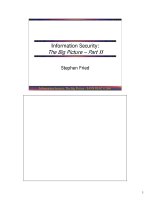INFORMATION SECURITY THROUGH IMAGE STEGANOGRAPHY USING LEAST SIGNIFICANT BIT ALGORITHM By NANI KODURI
Bạn đang xem bản rút gọn của tài liệu. Xem và tải ngay bản đầy đủ của tài liệu tại đây (1.15 MB, 63 trang )
MSc Information Security and Computer Forensics
0919879
Nani Koduri Page 1
INFORMATION SECURITY THROUGH IMAGE STEGANOGRAPHY
USING
LEAST SIGNIFICANT BIT ALGORITHM
By
NANI KODURI
Master of Science
in
Information Security and Computer Forensics
University of East London
MSc Information Security and Computer Forensics
0919879
Nani Koduri Page 2
ACKNOWLEDGEMENT:
I am extremely satisfied in successfully completing the dissertation for my
course MSc Information Security and Computer Forensics. I take this opportunity to
thank all my faculties and mentors who took a huge part in my progress. I would
especially like to thank Dr. David Preston who helped in completing the dissertation
with valuable suggestions and feedback ensuring my direction is correct in my first
research project. The UEL library and the Journal Access systems were extremely
helpful in providing me with the necessary knowledge to actively engage in the
project. I would like to thank my friends for helping me with their expertise in
Microsoft .NET technologies for building the steganographic application. Above all, I
am grateful to my parents for helping me to pursue this course.
MSc Information Security and Computer Forensics
0919879
Nani Koduri Page 3
TABLE OF CONTENTS
ABSTRACT
CHAPTER 1
1. INTRODUCTION…………………………………………………………… 7
1.1. PROBLEM STATEMENT………………………………………… 9
1.2. OBJECTIVES OF THE STUDY…………………………………… 9
1.3. RESEARCH METHOD…………………………………………… 9
1.4. SCOPE AND LIMITATIONS……………………………………… 10
1.5. THESIS OF THE PROJECT……………………………………… 11
CHAPTER 2
2. LITERATURE REVIEW…………………………………………………… 12
2.1. INFORMATION SECURITY……………………………………… 12
2.1.1. SECURITY ATTACKS………………………………………… 14
2.2. CRYPTOGRAPHY………………………………………………… 17
2.2.1. SYMMETRIC ENCRYPTION ………………………………… 19
2.2.2. ASYMMETRIC ENCRYPTION……………………………… 21
2.3. STEGANOGRAPHY……………………………………………… 22
2.3.1. LSB ALGORITHM……………………………………………… 24
2.3.2. JSTEG ALGORITHM…………………………………………….26
2.3.3. F5 ALGORITHM………………………………………………….26
2.4. DIGITAL WATERMARKING……………………………………… 27
CHAPTER 3
3. DESIGN……………………………………………………………………….29
3.1. ENCRYPTION PHASE…………………………………………… 30
3.2. TRANSMISSION PHASE………………………………………… 31
3.3. DECRYPTION PHASE…………………………………………… 32
3.4. DATA FLOW DIAGRAMS………………………………………… 32
3.4.1. CONSTRUCTING DATA FLOW DIAGRAM………………… 34
3.4.2. DATA FLOW DIAGRAM LEVEL 0…………………………… 34
3.4.3. DATA FLOW DIAGRAM LEVEL 1…………………………… 35
MSc Information Security and Computer Forensics
0919879
Nani Koduri Page 4
3.4.4. DATA FLOW DIAGRAM LEVEL 2………………………… 36
3.5. ACTIVITY DIAGRAM…………………………………………… 36
CHAPTER 4
4. EXECUTION…………………………………………………………………38
4.1. HARDWARE AND SOFTWARE REQUIREMENTS…………….38
4.1.1. MICROSOFT .NET………………………………………………38
4.1.2. CLR……………………………………………………………… 39
4.1.3. WINDOWS FORMS…………………………………………… 39
4.1.4. VISUAL C# 40
4.2. FEATURES OF PROPOSED METHOD………………………… 41
4.3. SYSTEM REQUIREMENTS……………………………………… 41
4.4. STEGANOGRAPHY MODULE IMPLEMENTATION…………….43
4.4.1. ENCRYPTION MODULE……………………………………… 43
4.4.2. DATA TRANSMISSION MODULE…………………………… 44
4.4.3. DECRYPTION MODULE……………………………………… 45
4.5. SCREENSHOT EXPLANATION……………………………………46
CHAPTER 5
5. TESTING……………………………………………………………………….51
5.1. AIM OF TESTING…………………………………………………… 52
5.2. ARTEFACTS OF TESTING………………………………………….52
5.3. UNIT TESTING……………………………………………………… 53
5.3.1. LIMITATIONS OF UNIT TESTING…………………………… 54
5.4. VALIDATION TESTING…………………………………………… 54
5.5. OUTPUT TESTING……………………………………………………54
5.6. INTEGRATION TESTING…………………………………………….54
5.6.1. TOP-DOWN APPROACH……………………………………… 55
5.6.2. BOTTOM-UP APPROACH………………………………………55
5.6.3. UMBRELLA APPROACH……………………………………… 55
5.7. USER ACCEPTACE TESTING…………………………………… 56
5.8. BLACK BOX AND WHITE BOX TESTING…………………………56
MSc Information Security and Computer Forensics
0919879
Nani Koduri Page 5
CHAPTER 6
6. RESULTS AND DISCUSSION……………………………………………… 57
CHAPTER 7
7. CONCLUSION AND FUTURE WORK………………………………………59
8. REFERENCES………………………………………………………………….60
MSc Information Security and Computer Forensics
0919879
Nani Koduri Page 6
ABSTRACT:
The rapid development of data transfer through internet made it easier to
send the data accurate and faster to the destination. There are many transmission
media to transfer the data to destination like e-mails; at the same time it is may be
easier to modify and misuse the valuable information through hacking. So, in order to
transfer the data securely to the destination without any modifications, there are
many approaches like cryptography and steganography. This paper deals with the
image steganography as well as with the different security issues, general overview
of cryptography, steganography and digital watermarking approaches and about the
different steganographic algorithms like Least Significant Bit (LSB) algorithm, JSteg,
F5 algorithms. It also compares those algorithms in means of speed, accuracy and
security.
This paper gives a brief idea about the new image steganographic approach
that make use of Least Significant Bit (LSB) algorithm for embedding the data into
the bit map image (.bmp) which is implemented through the Microsoft .NET
framework.
MSc Information Security and Computer Forensics
0919879
Nani Koduri Page 7
CHAPTER 1
1. INTRODUCTION
In the current trends of the world, the technologies have advanced so much
that most of the individuals prefer using the internet as the primary medium to
transfer data from one end to another across the world. There are many possible
ways to transmit data using the internet: via e-mails, chats, etc. The data transition is
made very simple, fast and accurate using the internet. However, one of the main
problems with sending data over the internet is the „security threat‟ it poses i.e. the
personal or confidential data can be stolen or hacked in many ways. Therefore it
becomes very important to take data security into consideration, as it is one of the
most essential factors that need attention during the process of data transferring.
Data security basically means protection of data from unauthorised users or hackers
and providing high security to prevent data modification. This area of data security
has gained more attention over the recent period of time due to the massive increase
in data transfer rate over the internet.
In order to improve the security features in data transfers over the internet, many
techniques have been developed like: Cryptography, Steganography and digital
watermarking. While Cryptography is a method to conceal information by encrypting
it to „cipher texts‟ and transmitting it to the intended receiver using an unknown key,
Steganography provides further security by hiding the cipher text into a seemingly
invisible image or other formats.
According to Johnson et al., (2001), “Steganography is the art of hiding and
transmitting data through apparently innocuous carriers to conceal the existence of
data”. The level of visibility is decreased using many hiding techniques in „Image
Modelling‟ like LSB „Manipulation‟, „Masking and filtering‟. These techniques are
performed by different steganographic algorithms like F5, LSB, JSteg etc. and the
act of detecting the information hidden through these algorithms is called
„Steganalysis‟. “Cryptography” is the art of science used to achieve security by
encoding the data to transform them into non readable formats so that unauthorized
users cannot gain access to it.
MSc Information Security and Computer Forensics
0919879
Nani Koduri Page 8
The encoded text is known as „Cipher text‟ and this technique is known as
encryption and this process is reversed with authorised access using the decryption
technique, in which the encoded data is decoded into readable format (Kahate,
2008).
„Steganography‟ and „Cryptography‟ are closely related constructs. The hidden or
embedded image, audio or a video files act as carriers to send the private messages
to the destination without any security breach. Steganography techniques can be
implemented on various file formats such as audio („.mp3‟, „.wmv.‟, etc.), video
(„.mpeg‟, „.dat‟, etc.) and images („.jpeg‟, „.bmp‟, etc.). However, the images are the
most preferred file format for this technique. At present, there are a lot of algorithms
that help in executing the steganography software. These tools are (Krenn, 2004).
“Digital watermarking” is described as one of the possibilities to close the gap
between copyright issues and digital distribution of data. It is mainly based on
Steganographic techniques and enables useful safety mechanisms (Jeffrey, 2008).
It acts as a very good medium for copyright issues as it embeds a symbol or a logo
in the form of a watermark, which cannot be altered manually.
One critical factor to be kept in mind when using steganography is to prevent any
further alterations to the originality of the image after embedding the data. Whenever
the image with the secret data is transmitted over the internet unauthorised parties
may want to hack the data hidden over the image. So, if the originality of the image
has been changed then it will be easier to hack the information by unauthorised
persons. In order to improve the security, the Digital watermarks are predominantly
inserted as transformed digital signal into the source data using key based
embedding algorithm and pseudo noise pattern.
This technique has also found big use in the notorious hands of terrorists and the
September 2001 Twin tower attacks of the USA are predominantly associated with
the communications using steganography. The Steganalysis aims at discovering and
decrypting the suspected data transferred with the use of the available algorithms.
MSc Information Security and Computer Forensics
0919879
Nani Koduri Page 9
1.1 PROBLEM STATEMENT:
The aim of the project is to encrypt the data i.e., hide the data over an image using
different steganographic algorithms and to compare those algorithms in the context
of speed, quality of concealing and the use of watermarks and to describe their
functionality in data security.
1.2 OBJECTIVES OF THE STUDY:
In my project I primarily concentrated on the data security issues when sending the
data over the network using steganographic techniques. The main objectives of the
project are
Overview of different steganographic algorithms and comparing them in means of
speed and quality of hiding.
Testing the efficiency and accuracy of hiding the data through algorithms using
different software.
1.3 RESEARCH METHOD:
In this project, I use a method of encrypting the text and audio files in an image file in
order to test the accuracy and efficiency of encryption. This process helps to send
the information to the authorised party without any potential risk. The proposed
method will help to secure the content with in the image and encryption of audio file
with in the image will help to make the document much securer because even
though if the unauthorised person succeeds in being able to hack the image, the
person will not able to read the message as well as acquire the information in the
audio file.
In this research, I will compare three steganographic algorithms in order to compare
the hiding capacity and efficiency of hiding the message with in an image. Whenever
the audio or data is encrypted using steganographic algorithms with in image, neither
the audio/data nor the image it is embedded in should lose its originality. Hence, we
compare the different algorithms used for steganography for the various hiding
techniques and formats and analyse the results obtained.
MSc Information Security and Computer Forensics
0919879
Nani Koduri Page 10
The process consists of
Providing security for the data to be transmitted through network using
steganography.
Using digital watermarking techniques
Implementing different steganographic algorithms
Comparing different steganographic algorithms in means of speed, accuracy and
quality of hiding.
Proposing an approach for hiding the data within an image using a
steganographic algorithm which provides better accuracy and quality of hiding.
The .NET software is used to extensively analyse the functions of the LSB algorithm
in steganography. Texts and other file formats are encrypted and embedded into an
image file which is then transferred to the destination. The file‟s changes in
resolution due to the pixels lost are analysed for suggesting the optimal method for
the technique.
1.4 SCOPE AND LIMITATIONS:
The scope of the project is to limit unauthorised access and provide better security
during message transmission. To meet the requirements, I use the simple and basic
approach of steganography and digital watermarking. In this project, the proposed
approach finds the suitable algorithm for embedding the data in an image using
steganography which provides the better security pattern for sending messages
through a network.
For practically implementing the function of the discussed algorithms, Microsoft .NET
framework is used. Although the Microsoft .NET is not particularly known for its top
security functionalities, I use this for easier application development and a well
defined User Interface.
MSc Information Security and Computer Forensics
0919879
Nani Koduri Page 11
1.5 THESIS OF THE PROJECT:
Chapter-1: Introduction: In this section, the main points discussed are about the
Overview, the Background of the project, the scopes and limitations of the project
and the approach to research employed are discussed.
Chapter-2: Literature Review: Definitions and overview about the different
information security methods to gather knowledge on the existing theories of
steganography and review it for proposing an improvised system for providing the
required security and discuss about different functionalities of algorithms used for the
proposed system.
Chapter-3: Design Structure: This section describes the general architecture of
encryption, decryption and data hiding procedures using Data Flow Diagrams.
Chapter-4: Implementation: Description about the hardware and software
requirements for the proposed system, overview of the .NET software and
implementations of different modules like encryption, decryption and data hiding
techniques. It also discusses about the advantages of the .NET system over the
other frameworks.
Chapter-5: Testing: Here, the algorithm proposed to analyse in different formats and
analyse on its operations is tested and error reports are prepared. The different
types of testing helps are considered to validate the built software on different
conditions.
Chapter-6: Conclusion and Future work: Here, the project is concluded with the
results of the proposed method that has been analysed and recommendations are
made according to the results obtained from the analysis.
MSc Information Security and Computer Forensics
0919879
Nani Koduri Page 12
CHAPTER 2
2. LITERATURE REVIEW
2.1 INFORMATION SECURITY
In general, security denotes “the quality or state of being secure to be free
from danger” (Whitman, 2007, pp.09). Security is classified into different layers
depending on the type of content intended to be secured:
Physical security: Defines the required issues that are needed to protect the physical
data or objects from unauthorized intrusion.
Personal security: It is defined as the security of the individuals who are officially
authorized to access information about the company and its operations
Operational security: It mainly relies on the protection of the information of a
particular operation of the chain of activities.
Communication‟s security: The communication‟s security encompasses the security
issues regarding the organisation‟s communication media, technology and content.
Network security: The network security is responsible for safeguarding the
information regarding the „networking components‟, „connections‟ and contents.
Information security:
Information security is the protection of information and the systems and hardware
that use, store, and transmit that information. Information security can be defined as
measures adopted to prevent the unauthorized use or modification of use of data or
capabilities.
The main objective of the project is to propose the method and critically discuss the
properties which help to transmit the data or information over a network without any
modifications. The critical characteristics of information are
1. Availability
2. Accuracy
3. Authenticity
MSc Information Security and Computer Forensics
0919879
Nani Koduri Page 13
4. Confidentiality
5. Integrity
Availability: prevention of unauthorised disclosure of information. It enables users
who need access the information to do so without any interference or obstruction
and to receive it in the required format. The availability of information requires the
verification of the user as one with authorized access to information (Whitman,
2007).
In other words the availability can be defined as “Ensuring timely and reliable access
to make use of information. A loss of availability is the disruption of access to or use
of information or an information system” (Stallings, 2007, pp.09).
Accuracy: The information is deemed accurate if it does not contain any mistakes /
errors and possesses the value that end user expects. If the information holds a
value different from that of the end user‟s expectations because of intentional or
unintentional modifications of its content it becomes no longer accurate (Whitman,
2007).
Authenticity: Authenticity refers to the quality or state of being genuine or original. It
should not be a reproduction or fabrication of any previously known data. The
Information is considered authentic when it is originally created, placed, stored or
transferred. In general, authenticity is ensuring that all the data remains in its original
state by stopping any ways of the unauthorised modification of information
(Whitman, 2007).
Confidentiality: “The confidentiality is the quality or state of preventing disclosure or
exposure to unauthorized individuals or system”. Confidentiality is basically privacy
and secrecy which means protection of personal data or that of data belonging to an
organisation. Confidentiality of information ensures that only those with the rights
and privileges access a particular set of information and prevent from unauthorized
access (Whitman, 2007).
MSc Information Security and Computer Forensics
0919879
Nani Koduri Page 14
Integrity: It is the prevention of unauthenticated modification of data. “The quality or
state of being whole, complete and uncorrupted is the integrity of information”. The
integrity of any data is lost when it is subjected to corruption, damage (external /
internal), destruction or other disruption of its authentic state by intended or
unintended sources (Whitman, 2007).
2.1.1 Security attacks:
The data is transmitted from source to destination which is known as its normal flow
as shown in the figure. But the hackers might hack the network in order to access or
modify the original data. These types of attacks are formally known as security
attacks.
Figure 1: Normal data flow
A hacker can disrupt this normal flow by implementing the different types of
techniques over the data and network in following ways. They are:
Interruption
Interception
Modification
Fabrication
Source info destination info
MSc Information Security and Computer Forensics
0919879
Nani Koduri Page 15
Interruption:
Interruption is an attack by which the hackers can interrupt the data before reaching
the destination. This type of attack shows the effect on availability and usually
destroys the system asset and makes the data unavailable or useless.
Figure 2: Interruption
Interception:
Interception is one of the well known attacks. When the network is shared that is
through a local area network is connected to Wireless LAN or Ethernet it can receive
a copy of packets intended for other device. On the internet, the determined hacker
can gain access to email traffic and other data transfers. This type of attack shows
the effect on confidentiality of data.
Figure 3: Interception
Source info destination info
Source info destination info
MSc Information Security and Computer Forensics
0919879
Nani Koduri Page 16
Modification:
This refers to altering or replacing of valid data that is needed to send to destination.
This type of attacks is done usually by unauthorized access through tampering the
data. It shows effect on the integrity of the data.
Figure 4: Modification
Fabrication:
In this type, the unauthorized user places data without the interface of source code.
The hacker or unauthorized person inserts the unauthorized objects by adding
records to the file, insertion of spam messages etc. This type of attack affects on the
Authenticity of message.
Figure 5: Fabrication
There are many types of security attacks that will try to modify the original data. The
main goal of any organisation / individual transmitting the data is to implement
security measures which include
Source info destination info
Source info destination info
MSc Information Security and Computer Forensics
0919879
Nani Koduri Page 17
1. Prevention
2. Detection
3. Response
4. Recovery
Prevention: The security attacks can be prevented by using an encryption algorithm
to restrict any unauthorized access to the encryption keys. Then the attacks on
confidentiality of the transmitted data will be prevented.
Detection: Using the intrusion detection systems for detection of unauthorized
individuals logged onto a system and making the resources available to legitimate
users.
Response: Whenever the unauthorised attacks happen in the system, the security
mechanisms can detect the process and the system can respond to make the data
unavailable.
Recovery: Recovery is the final approach if an attacker modifies the data or makes
the data unavailable. The data can then be recovered by using backup systems, so
that the integrity of the data shall not be compromised.
There are different types of approaches for preventing the security attacks. The most
useful approaches are
1. Cryptography
2. Steganography
3. Digital watermarking
2.2 CRYPTOGRAPHY
The word cryptography is derived from two Greek words which mean “secret writing”.
Cryptography is the process of scrambling the original text by rearranging and
substituting the original text, arranging it in a seemingly unreadable format for others.
Cryptography is an effective way to protect the information that is transmitting
through the network communication paths (Bishop, 2005).
MSc Information Security and Computer Forensics
0919879
Nani Koduri Page 18
Cryptology is the science that deals about cryptography and cryptanalysis.
Cryptography is the approach of sending the messages secretly and securely to the
destination. Cryptanalysis is the method of obtaining the embedded messages into
original texts (Whitman, 2007).
In general, cryptography is transferring data from source to destination by altering it
through a secret code. The cryptosystems uses a plaintext as an input and generate
a cipher text using encryption algorithm taking secret key as input.
The important elements in cryptosystems are
1. Plain text (input)
2. Encryption algorithm
3. Secret key
4. Cipher text
5. Decryption algorithm
Figure 6: General model of cryptographic system
Plain text: The plain text is an original piece of information that is needed to send
information to the destination.
MSc Information Security and Computer Forensics
0919879
Nani Koduri Page 19
Encryption algorithm: This is the main key to any cryptographic system. This
encryption algorithm subjects the plain text to various substitutions and
transformations.
Secret key: The secret key is given by the user which will act as an input to the
encryption algorithm. Based on this key, various substitutions and transformations on
the plain text will differ.
Cipher text: This is the output generated by the encryption algorithm. The cipher text
is the jumbled text. The cipher text differs with each and every secret key that has
given to the encryption algorithm.
Decryption algorithm: This is opposite to the „encryption algorithm‟. It will acquire
cipher text and secret key as an input and produce plain text as an output.
Cryptographic Algorithms: There are many cryptographic algorithms available which
differ on their type of encryption. Based on the type of encryption standards the
algorithms are grouped into two types
1. Symmetric encryption algorithm
2. Asymmetric encryption algorithm
2.2.1 Symmetric Encryption
Symmetric encryption is a single key encryption and also known as conventional
encryption. It is also referred as „private key cryptography‟. The symmetric encryption
algorithm generally uses the same key for „encryption‟ and „decryption‟. The security
level for this type of encryption will depend on the length of the key.
Figure 7: Symmetric encryption
MSc Information Security and Computer Forensics
0919879
Nani Koduri Page 20
There are two types of methods that will attack on symmetric encryption systems.
The first one is Cryptanalysis. If the attacker gets to know some information about
the plain text and cipher text, he analyses the characteristics of the algorithms used
for encryption and tries to generate keys. The second type of attack is known as
„brute force attack‟. In this type of attack, the defender attempts to know the cipher
text and try every possible key for translation. To avoid this problem, the user should
use the key that no longer can be estimated like 128 or 168 bit keys (Alfred J, M et
al., 1996).
Block ciphers: Block cipher is an asymmetric algorithm in which the cipher processes
the text in fixed size blocks and generates same size cipher text blocks. In this
algorithm, the plaintext is divided into independent blocks of 8-16 bytes and encrypts
each block independently.
The different symmetric encryption algorithms are
Data encryption standard
Advanced encryption standard
Data encryption standard (DES):
„Data Encryption Standard‟ (DES) is also known as Data Encryption Algorithm
(DEA). DEA takes 64 bits of plain text and 56 bits of key to produce 64 bits cipher
text block. The DES algorithm always functions on blocks of equal size and uses the
permutations and substitutions in algorithm.
The data encryption algorithm uses 56 bit key so it is not possible for the defender
for analysing the key. So, the problem of Cryptanalysis is avoided using this
algorithm. But the drawback of the algorithm is Brute-force attack. This can be
avoided using the Triple DES algorithm.
Triple DES:
Triple DES is an extension to the DES algorithm. Triple DES uses the same
approach for encryption as DES. 3DES takes three 64 bit keys which has a total
length of 192 bits. We can give more than one key that is two or three keys for
encryption as well as for decryption such that the security will be stronger. It is
MSc Information Security and Computer Forensics
0919879
Nani Koduri Page 21
approximately 2
56
times stronger than the normal DES algorithm, so that this
algorithm can avoid the brute force attack. The main drawback of using 3DES
algorithm is that the number of calculations is high reducing the speed to a greater
extent. And the second drawback is that both DES and 3DES use same 64 block
size to avoid security issues. “Advanced Encryption Standard” algorithms are used to
avoid these limitations.
Advanced Encryption Standards:
Advanced Encryption Standards (AES) takes a block of size 128 bits as input and
produces the output block of same size. AES supports different key sizes like 128,
192 and 256 bit keys. Each encryption key size will change the number of bits and
also the complexity of cipher text.
The major limitation of AES is error propagation. The encryption operation and key
generation both engage in number of non linear operations, so, for lengthy
operations it is not suitable. A cryptanalyst may able to use the continuities in plain
text to simplify the decryption (Whitman, 2007).
2.2.2 Asymmetric Encryption
„Asymmetric encryption‟ is also known as „Public key encryption‟. The AES works
same as Symmetric encryption, the main difference between AES and Symmetric
encryption is in using keys. In asymmetric encryption, the encryption and decryption
will be done by two different keys. It will use plain text, encryption algorithm and
decryption algorithm same as Symmetric encryption as discussed in above section.
Figure 8: Asymmetric Encryption
MSc Information Security and Computer Forensics
0919879
Nani Koduri Page 22
In „Asymmetric encryption‟, only the data that is encrypted using public key can be
decrypted using the same algorithm. And the message which is encrypted using
private key can be decrypted using only the matching public key.
The main problem with Asymmetric algorithm is “cipher keys”. Whenever two
different people want to exchange the data simultaneously using asymmetric
encryption they need to have four different keys. It will be more confusing to resolve
as the corresponding key is required for the particular file to open.
The most important public key encryption algorithm is RSA algorithm
RSA:
RSA was first developed in 1977. RSA functions depend upon the large prime
numbers of public and private keys. The security is also based on the difficulty of
prime numbers. The RSA algorithms are used in public key encryptions as well as in
digital signatures. It allows the sender to encrypt the message using public key and
decrypt the message using private key by receiver. So, the security will be high using
RSA in public key encryption (Stallings, 2007).
2.3 STEGANOGRAPHY
Steganography in Greek means „covered writing‟. Steganography is the process of
hiding the one information into other sources of information like text, image or audio
file, so that it is not visible to the natural view. There are varieties of steganographic
techniques available to hide the data depending upon the carriers we use.
Steganography and cryptography both are used for the purpose of sending the data
securely. The same approach is followed in Steganography as in cryptography like
encryption, decryption and secret key. In steganography the message is kept secret
without any changes but in cryptography the original content of the message is
differed in different stages like encryption and decryption.
Steganography supports different types of digital formats that are used for hiding the
data. These files are known as carriers. Depending upon the redundancy of the
object the suitable formats are used. „Redundancy‟ is the process of providing better
accuracy for the object that is used for display by the bits of object.
MSc Information Security and Computer Forensics
0919879
Nani Koduri Page 23
The main file formats that are used for steganography are Text, images, audio,
video, protocol (Morkel, 2005).
The different types of steganographic techniques that is available are
1. Pure steganography
2. Public key steganography
3. Secret key steganography
Pure steganography: Pure steganography is the process of embedding the data
into the object without using any private keys. This type of steganography entirely
depends upon the secrecy. This type of steganography uses a cover image in which
data is to be embedded, personal information to be transmitted, and encryption
decryption algorithms to embed the message into image.
Figure 9: pure steganography process (Zaidoon, 2010).
This type of steganography can‟t provide the better security because it is easy for
extracting the message if the unauthorised person knows the embedding method. It
has one advantage that it reduces the difficulty in key sharing (Zaidoon, 2010).
Secret key steganography: Secret key steganography is another process of
steganography which uses the same procedure other than using secure keys. It uses
the individual key for embedding the data into the object which is similar to
symmetric key. For decryption it uses the same key which is used for encryption.
Figure 10: secret key steganography (Zaidoon, 2010).
MSc Information Security and Computer Forensics
0919879
Nani Koduri Page 24
This type of steganography provides better security compared to pure
steganography. The main problem of using this type of steganographic system is
sharing the secret key. If the attacker knows the key it will be easier to decrypt and
access original information (Zaidoon, 2010).
Public key steganography: Public key steganography uses two types of keys: one
for encryption and another for decryption. The key used for encryption is a private
key and for decryption, it is a „public key‟ and is stored in a public database
(Zaidoon, 2010).
Figure 11: public key steganography (Zaidoon, 2010).
For encryption and decryption of text messages using the secret keys
steganographic system uses algorithms known as steganographic algorithms. The
mostly used algorithms for embedding data into images are
1. LSB (Least Significant Bit ) Algorithm
2. JSteg Algorithm
3. F5 Algorithm
2.3.1 LSB algorithm
LSB (Least Significant Bit) substitution is the process of adjusting the least significant
bit pixels of the carrier image. It is a simple approach for embedding message into
the image. The Least Significant Bit insertion varies according to number of bits in an
image. For an 8 bit image, the least significant bit i.e., the 8
th
bit of each byte of the
image is changed to the bit of secret message. For 24 bit image, the colours of each
component like RGB (red, green and blue) are changed. LSB is effective in using
BMP images since the compression in BMP is lossless. But for hiding the secret
message inside an image of BMP file using LSB algorithm it requires a large image
which is used as a cover. LSB substitution is also possible for GIF formats, but the
MSc Information Security and Computer Forensics
0919879
Nani Koduri Page 25
problem with the GIF image is whenever the least significant bit is changed the
whole colour palette will be changed. The problem can be avoided by only using the
gray scale GIF images since the gray scale image contains 256 shades and the
changes will be done gradually so that it will be very hard to detect. For JPEG, the
direct substitution of steganographic techniques is not possible since it will use lossy
compression. So it uses LSB substitution for embedding the data into images. There
are many approaches available for hiding the data within an image: one of the simple
least significant bit submission approaches is „Optimum Pixel Adjustment
Procedure‟. The simple algorithm for OPA explains the procedure of hiding the
sample text in an image.
Step1: A few least significant bits (LSB) are substituted with in data to be hidden.
Step2: The pixels are arranged in a manner of placing the hidden bits before the
pixel of each cover image to minimize the errors.
Step3: Let n LSBs be substituted in each pixel.
Step4: Let d= decimal value of the pixel after the substitution.
d1 = decimal value of last n bits of the pixel.
d2 = decimal value of n bits hidden in that pixel.
Step5: If (d1~d2)<=(2^n)/2
then no adjustment is made in that pixel.
Else
Step6: If(d1<d2)
d = d – 2^n.
If(d1>d2)
d = d + 2^n.
This„d‟ is converted to binary and written back to pixel (Amirtharajan et al., 2010).
This method of substitution is simple and easy to retrieve the data and the image
quality better so that it provides good security.









